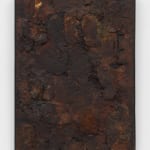-
Artworks








Sin título - Chatarra (Untitled – Metal Scrap), 1962
Metal sheet and mixed media on canvas24 3/4 x 18 1/8 in.
62.9 x 46 cmFurther images
-
(View a larger image of thumbnail 1
)

-
(View a larger image of thumbnail 2
)

-
(View a larger image of thumbnail 3
)

-
(View a larger image of thumbnail 4
)

-
(View a larger image of thumbnail 5
)

-
(View a larger image of thumbnail 6
)

-
(View a larger image of thumbnail 7
)

-
(View a larger image of thumbnail 8
)

Beginning in the early 1960s, Gramcko worked on different series of three-dimensional collages and assemblages. If Surrealism was based on the reconciliation of distant realities, Gramcko’s reconfigured assemblages are based...Beginning in the early 1960s, Gramcko worked on different series of three-dimensional collages and assemblages. If Surrealism was based on the reconciliation of distant realities, Gramcko’s reconfigured assemblages are based on the reconciliation of binary categories such as painting–sculpture, inside–outside, inward–outward, and unformed–formed. In these works, there is a systematic incorporation of different types of industrial elements for the creation of the artwork, which responds to a progression of intimate identification, and an emotional and spiritual relationship between the artist and the objects at her disposal.
In her explorations of coarse surfaces, Gramcko made use of scrap metal as compositional elements, which she combined with oxide pigments. She referred to the works in this series as “Chatarras (Scrap Metals)”. “Sin título - Chatarra (Untitled – Metal Scrap),” 1962 can be read as a corrosive terrain unfurling on the surface of the canvas.Provenance
Elsa Gramcko, Caracas, Venezuela
Esso Álvarez, Caracas, VenezuelaExhibitions
Hierros. Galeria G, Caracas, Venezuela, 1962.Publications
Rangel Gabriela, Aruna D’Souza. Elsa Gramcko: The Invisible Plot of Things. Published by Sicardi | Ayers | Bacino, James Cohan, printed by Faenza Group, Italy, 2022, p. 57.
El Farol magazine published by Creole Petroleum Corporation, Caracas, Venezuela, 1962, [Cover images]
1of 2 -
(View a larger image of thumbnail 1
)







